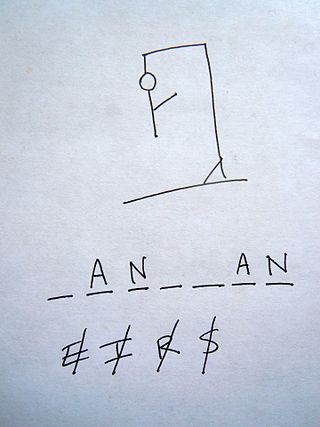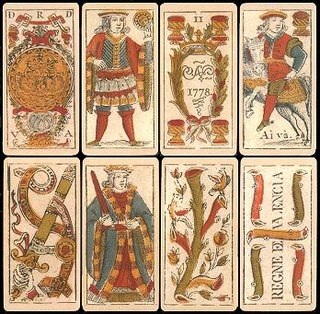Related Research Articles

A mathematical game is a game whose rules, strategies, and outcomes are defined by clear mathematical parameters. Often, such games have simple rules and match procedures, such as tic-tac-toe and dots and boxes. Generally, mathematical games need not be conceptually intricate to involve deeper computational underpinnings. For example, even though the rules of Mancala are relatively basic, the game can be rigorously analyzed through the lens of combinatorial game theory.

Paper-and-pencil games or paper-and-pen games are games that can be played solely with paper and pencils, usually without erasing. They may be played to pass the time, as icebreakers, or for brain training. In recent times, they have been supplanted by mobile games. Some popular examples of pencil-and-paper games include tic-tac-toe, sprouts, dots and boxes, hangman, MASH, paper soccer, and spellbinder. The term is unrelated to the use in role-playing games to differentiate tabletop games from role-playing video games.

Tic-tac-toe, noughts and crosses, or Xs and Os is a paper-and-pencil game for two players who take turns marking the spaces in a three-by-three grid with X or O. The player who succeeds in placing three of their marks in a horizontal, vertical, or diagonal row is the winner. It is a solved game, with a forced draw assuming best play from both players.
Sid Sackson was an American board game designer and collector, best known as the creator of the business game Acquire.

Epaminondas is a strategy board game invented by Robert Abbott in 1975. The game is named after the Theban general Epaminondas, known for the use of phalanx strategy in combat. The concept of the phalanx is integral to the game.

Many games can be played with Go equipment: a supply of white and black stones and a board with 19×19 intersections, other than Go and many more can be played with minor modification.
Crossings is a two-player abstract strategy board game invented by Robert Abbott. The rules were published in Sid Sackson's A Gamut of Games. Crossings was the precursor to Epaminondas, which uses a larger board and expanded rules.

3D tic-tac-toe, also known by the trade name Qubic, is an abstract strategy board game, generally for two players. It is similar in concept to traditional tic-tac-toe but is played in a cubical array of cells, usually 4×4×4. Players take turns placing their markers in blank cells in the array. The first player to achieve four of their own markers in a row wins. The winning row can be horizontal, vertical, or diagonal on a single board as in regular tic-tac-toe, or vertically in a column, or a diagonal line through four boards.

Focus is an abstract strategy board game, designed by Sid Sackson and first published in 1963 by Kosmos. The game has been re-published many times since, sometimes under the titles Domination or Dominio. Focus won the 1981 Spiel des Jahres and Essen Feather awards. The game appears in Sackson's A Gamut of Games in the section New Battles on an Old Battlefield.
Haggle is a party game designed by Sid Sackson and intended for a large number of players. It is rather complex and involved compared to many party games and, as a result, is often played only at gatherings of people who are known to enjoy gaming at other times.
Games World of Puzzles is an American games and puzzle magazine. Originally the merger of two other puzzle magazines spun off from its parent publication Games magazine in the early 1990s, Games World of Puzzles was reunited with Games in October 2014.

Hoyle's Official Book of Games is a series of computer games released from 1989 to 2016 that was initially developed and published by Sierra On-Line. The series focuses primarily on playing cards, but has also included board games, puzzles, dice, and dominos. It spawned a spin-off series dedicated to casino table games and machines called Hoyle Casino in 1996.
There were various games and applications available in Windows Live Messenger that could be accessed via the conversation window by clicking the games icon and challenging a "buddy".

Zillions of Games is a commercial general game playing system developed by Jeff Mallett and Mark Lefler in 1998. The game rules are specified with S-expressions, Zillions rule language. It was designed to handle mostly abstract strategy board games or puzzles. After parsing the rules of the game, the system's artificial intelligence can automatically play one or more players. It treats puzzles as solitaire games and its AI can be used to solve them.

Truc, pronounced in France and in Spain, is a 15th-century bluff and counter-bluff trick-taking card game which has been likened to poker for two. It is played in Occitania, Sarthe, Poitou (tru) and the Basque Country (truka), and is still very popular in the Valencia region. More elaborate versions are widely played in Argentina, Uruguay, Venezuela, Paraguay and Brazil under such names as Truco, Truque and Truquiflor. The French version Le Truc has become more widely known in the English-speaking world and among hobbyist gamers after Sid Sackson included it in his popular book A Gamut of Games (1969), it being a translation of E. Lanes' 1912 book, Nouveau Manuel Complet des Jeux de Cartes.
Bowling Solitaire is a patience or solitaire card game that uses a single deck standard playing cards to simulate a round of ten-pin bowling.

Tic-tac-toe is an instance of an m,n,k-game, where two players alternate taking turns on an m×n board until one of them gets k in a row. Harary's generalized tic-tac-toe is an even broader generalization. The game can also be generalized as a nd game. The game can be generalised even further from the above variants by playing on an arbitrary hypergraph where rows are hyperedges and cells are vertices.
Sleuth is a strategy deduction card game designed by Sid Sackson and published by 3M in 1971. It is a reimplementation of the 1967 game The Case of the Elusive Assassin without the game board. The object of the game is to deduce the identity of a missing gem by questioning other players and gathering evidence, similar to Cluedo.

Gobs of Games, released in Europe as Games Frenzy, is a 2000 video game for the Game Boy Color developed by 2N Productions and published by The 3DO Company, who showcased the game at E3 2000. The game is a compilation of compilation of puzzle games, including simplified iterations of traditional games, including peg solitaire, checkers and tic tac toe.
References
- Sackson, Sid. A Gamut of Games. ISBN 0-486-27347-4